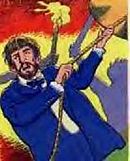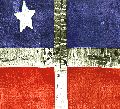Manuel Rojas Luzardo: Difference between revisions
Marine 69-71 (talk | contribs) mNo edit summary |
Marine 69-71 (talk | contribs) m update |
||
| Line 1: | Line 1: | ||
{{Infobox military person |
{{Infobox military person |
||
|name= Manuel Rojas |
|name= Manuel Rojas |
||
|birth_date= |
|birth_date= 1831 |
||
|death_date= October 14, 1903 |
|death_date= October 14, 1903 |
||
|birth_place=City of Obispos in the state of Barinas, [[Venezuela]] |
|birth_place=City of Obispos in the state of Barinas, [[Venezuela]] |
||
| Line 18: | Line 18: | ||
|awards= |
|awards= |
||
}} |
}} |
||
Commander '''Manuel Rojas''' ( |
Commander '''Manuel Rojas''' (1831 – October 14, 1903), Commander of the Puerto Rican Liberation Army, was one of the main leaders of the [[Grito de Lares]] uprising against Spanish rule in [[Puerto Rico]]. |
||
==Early years== |
==Early years== |
||
Rojas (birth name: '''Manuel Rojas Luzardo''') was born in |
Rojas (birth name: '''Manuel Rojas Luzardo''') was born in the city of Obispos in the state of [[Barinas]], [[Venezuela]], from a [[Puerto Rican people|Puerto Rican]] father and a Venezuelan mother. There he recieved his primary and secondary education. Rojas was a dedicated agricultural worker and when he had saved enough money he moved to [[Valencia]], Spain where he became a successful businessmen.<ref name="VP">[http://venelib-antao.blogspot.com/2009/10/un-venezolano-promotor-de-la.html UN VENEZOLANO PROMOTOR DE LA INDEPENDENCIA DE PUERTO RICO'</ref> In the early 19th century Venezuela's economy was in turmoil because of internal wars. Rojas decided to go to Puerto Rico where he met and married Obdulia de los Ríos.<ref name="VP"/> |
||
The Rojas family moved close to the town of [[Lares, Puerto Rico|Lares]] where they settled down. The region was mountainous and its main income came from the coffee crop. Rojas and his brother, Miguel eventually bought and cultivated a 300 acre (1.2 km²) coffee plantation. The successful plantation was called "El Triunfo", and both men became wealthy merchants.<ref name="ROJAS">[http://www.loc.gov/rr/hispanic/1898/rojas.html Manuel Rojas]</ref> His brother Miguel meet [[Mariana Bracetti]] while on a business trip to [[Añasco, Puerto Rico|Añasco]]. Miguel and Mariana married and moved to "El Triunfo" where the Rojas lived.<ref name="PRI">[http://lcweb2.loc.gov/ammem/collections/puertorico/bras5.htmlIn Search of a National Identity: Nineteeth- and Early-Twentieth-Century Puerto Rico]</ref> |
|||
==Puerto Rico's independence movement== |
==Puerto Rico's independence movement== |
||
| Line 76: | Line 78: | ||
| ALTERNATIVE NAMES = |
| ALTERNATIVE NAMES = |
||
| SHORT DESCRIPTION = |
| SHORT DESCRIPTION = |
||
| DATE OF BIRTH = |
| DATE OF BIRTH = 1831 |
||
| PLACE OF BIRTH = City of Obispos in the state of Barinas, [[Venezuela]] |
| PLACE OF BIRTH = City of Obispos in the state of Barinas, [[Venezuela]] |
||
| DATE OF DEATH = October 14, 1903 |
| DATE OF DEATH = October 14, 1903 |
||
| Line 82: | Line 84: | ||
}} |
}} |
||
{{DEFAULTSORT:Rojas, Manuel}} |
{{DEFAULTSORT:Rojas, Manuel}} |
||
[[Category: |
[[Category:1831 births]] |
||
[[Category:1903 deaths]] |
[[Category:1903 deaths]] |
||
[[Category:People from Lares, Puerto Rico]] |
[[Category:People from Lares, Puerto Rico]] |
||
Revision as of 04:40, 2 March 2012
Manuel Rojas | |
|---|---|
 Drawing of Manuel Rojas | |
| Born | 1831 City of Obispos in the state of Barinas, Venezuela |
| Died | October 14, 1903 City of Boconó in the state of Trujillo, Venezuela |
| Allegiance | Puerto Rico |
| Service/ | "Revolution Committee of Puerto Rico" |
| Rank | Commander |
| Commands | Puerto Rican Liberation Army |
| Battles/wars | El Grito de Lares |
Commander Manuel Rojas (1831 – October 14, 1903), Commander of the Puerto Rican Liberation Army, was one of the main leaders of the Grito de Lares uprising against Spanish rule in Puerto Rico.
Early years
Rojas (birth name: Manuel Rojas Luzardo) was born in the city of Obispos in the state of Barinas, Venezuela, from a Puerto Rican father and a Venezuelan mother. There he recieved his primary and secondary education. Rojas was a dedicated agricultural worker and when he had saved enough money he moved to Valencia, Spain where he became a successful businessmen.[1] In the early 19th century Venezuela's economy was in turmoil because of internal wars. Rojas decided to go to Puerto Rico where he met and married Obdulia de los Ríos.[1]
The Rojas family moved close to the town of Lares where they settled down. The region was mountainous and its main income came from the coffee crop. Rojas and his brother, Miguel eventually bought and cultivated a 300 acre (1.2 km²) coffee plantation. The successful plantation was called "El Triunfo", and both men became wealthy merchants.[2] His brother Miguel meet Mariana Bracetti while on a business trip to Añasco. Miguel and Mariana married and moved to "El Triunfo" where the Rojas lived.[3]
Puerto Rico's independence movement

Rojas admired Puerto Rican independence advocate Ramón Emeterio Betances and together with his brother Miguel, joined Betances in his quest for Puerto Rico's independence. A "Revolution Committee of Puerto Rico" was formed and directed by Betances and Segundo Ruiz Belvis, who were exiled, from the Dominican Republic. Several revolutionary cells were formed in the towns and cities in the western part of the island. They were to support the armed invasion that Betances had planned to bring from the Dominican Republic.[2]
Two of the most important cells were that of Mayagüez, whose leader was Mathias Brugman and code named "Capa Prieto" and that of Lares, code named "Centro Bravo" and headed by Manuel Rojas. "Centro Bravo" was the main center of operations and was located in the Rojas plantation. Manuel Rojas was named "Commander of the Liberation Army" by Betances. Mariana Bracetti (wife of Miguel) was named "Leader of the Lares Revolutionary Council". Upon the request of Betances, Bracetti knitted the revolutionary Flag of Lares known as "La Bandera de Lares".[3]
The Revolutionary Committee named twelve of their members generales. They were[4]:
- Manuel Rojas, Commander in Chief of the Liberation Army
- Andres Pol, General of Division
- Juan de Mata Terraforte, General of Division
- Joaquín Parrilla, General of Division
- Nicolás Rocafort, General of Division
- Gabino Plumey, General of Division
- Dorvid Beauchamp, General of Division
- Mathías Brugman, General of Division
- Rafael Arroyo, General of Division
- Francisco Arroyo, General of Division
- Pablo Rivera, Calvary General
- Abdón Pagán, Artillery General
The Spanish authorities found out about the plot and were able to confiscate the armed ship which Betances had, before it arrived in Puerto Rico. The Mayor of the town of Camuy, Manuel González (who also happened to be the leader of that town's revolutionary cell) was arrested and charged with treason. He was able to hear that the Spanish Army was aware of the independence plot. He then escaped and was able to warn Manuel Rojas.[2]
El Grito de Lares

Because of this event, the revolutionists decided to start the revolution as soon as possible and set the date for September 23, 1868. Mathias Brugman and his men joined up with Manuel Rojas's men and with about 800 men and women, marched and took the town of Lares in what is known as "El Grito de Lares". The revolutionists entered the town's church and placed the revolutionary flag knitted by Bracetii on the High Altar as a sign that the revolution had begun. They declared Puerto Rico to be the "Republic of Puerto Rico" and named Francisco Ramírez Medina President of the Republic of Puerto Rico.[3]
Rojas and his poorly armed followers proceeded to march on to the town of San Sebastián, armed only with clubs and machetes. The Spanish Army had been forewarned and were waiting for them with superior firepower. When the revolutionists arrived, they were met with deadly fire.[2]
The revolt failed and many of the revolutionists were killed and at least 475 including, Manuel Rojas and Mariana Bracetii were imprisoned in the jail of Arecibo and sentenced to death. Some of them fled and went into hiding. Mathias Brugman was hiding in a local farm when a farm hand by the name of Francisco Quiñones, betrayed him and led the Spanish Authorities to Brugman's hiding place. He was executed on the spot.[3]
Aftermath
He was arrested that October and sentenced to death by a court-martial, but upon orders from the new Republican Spanish Government, the incoming governor of Puerto Rico, Jose Sanz, granted a general amnesty to all those imprisoned, effective on September 20, 1869. Manuel Rojas along with some of the other men involved in the revolution were sent into exile.[5]
Rojas was exiled to Venezuela and went to live in Boconó a city in the Venezuelan Andean state of Trujillo. Little is known about what he did after he went into exile except that he died in October 14, 1903, in he died in Boconó.[3] On December 25, 2002, the Government of Puerto Rico approved Public Law #291, which instructed the Institute of Puerto Rican Culture to study the possibility of transferring the remains of Manuel Rojas, considered by many to be among Puerto Rico's greatest independence leaders, to Puerto Rico.[6]
See also
References
- ^ a b [http://venelib-antao.blogspot.com/2009/10/un-venezolano-promotor-de-la.html UN VENEZOLANO PROMOTOR DE LA INDEPENDENCIA DE PUERTO RICO'
- ^ a b c d Manuel Rojas
- ^ a b c d e Search of a National Identity: Nineteeth- and Early-Twentieth-Century Puerto Rico
- ^ "Historia militar de Puerto Rico, Coleccion Encuentros"; By Negroni, Hector Andres (1992) (in Spanish); publisher: Sociedad Estatal Quinto Centenario. ISBN 8478441387.
- ^ Puerto Rico Encyclopedia
- ^ Ley Núm. 291 del año 2002 (Spanish)
